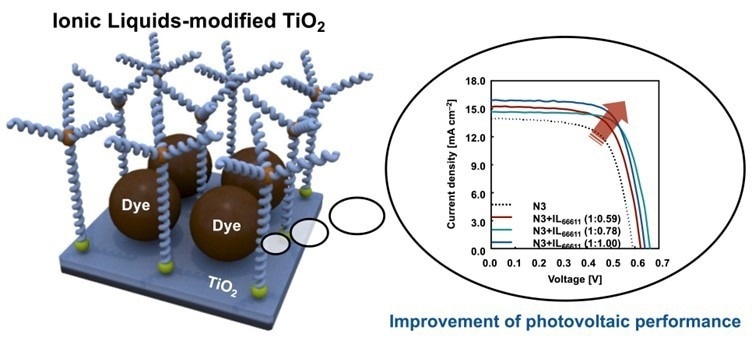Solar cells are rapidly becoming a major means of producing clean electricity in many nations. An enormous amount of work has been put into popularizing solar power over the past few decades. However, there are now several obstacles that prevent the technology from being used widely.
 Ionic liquids prevent the aggregation of dye molecules in solar cells. By modifying the surface of the oxide electrode with molten ionic salts, one can prevent the clumping of dye molecules without significantly impacting their coverage. This simple modification greatly improves the energy-conversion performance of dye-sensitized solar cells, find researchers from NITech, Japan in a new study. Image Credit: Tomohiko Inomata from Nagoya Institute of Technology, Japan.
Ionic liquids prevent the aggregation of dye molecules in solar cells. By modifying the surface of the oxide electrode with molten ionic salts, one can prevent the clumping of dye molecules without significantly impacting their coverage. This simple modification greatly improves the energy-conversion performance of dye-sensitized solar cells, find researchers from NITech, Japan in a new study. Image Credit: Tomohiko Inomata from Nagoya Institute of Technology, Japan.
In dye-sensitized solar cells (DSSCs), a promising photovoltaic technology, a major problem is dye aggregation. By design, DSSCs are photosynthesis-imitating electrochemical systems that rely on unique photosensitive dyes to turn sunlight into electricity.
The dye should ideally be coated evenly over the surface of an oxide electrode placed beneath a transparent layer so that electrons in the dye can efficiently transfer energy from absorbed sunlight. An external circuit is powered by the free electrons produced by this process.
However, most dyes have a propensity to collect on the electrode surface, impeding the ideal passage of both light and electric charges. This has a negative impact on DSSC performance that has been challenging to overcome.
Thankfully, a group of researchers from Nagoya Institute of Technology, Japan, under the direction of Associate Professor Tomohiko Inomata, may have just discovered a solution for this issue. They demonstrated in a recent work published in RSC Advances that specific ionic liquids (molten salts in a liquid form at relatively low temperatures) can effectively inhibit dye aggregation.
Other members of this research team included Ms. Ayaka Matsunaga and Prof. Tomohiro Ozawa from Nagoya Institute of Technology, and Prof. Hideki Masuda from Aichi Institute of Technology, Japan.
How do ionic liquids manage to accomplish this? The researchers concentrated on two ionic liquids with noticeably different molecular sizes and two kinds of dyes to clarify the precise mechanism at work.
Both ionic liquids shared the same molecular make-up, which included a titanium dioxide (TiO2) anchor that binds well to the electrode, a main polymer chain connecting this anchor to a phosphor atom, and three additional short polymer chains sticking out from the phosphor atom and away from the main “vertical” chain.
The TiO2 electrodes were immersed in solutions with various dye-to-ionic-liquid ratios, and the investigators carefully examined how the various molecules attached to them. After refining the manufacturing process, they discovered that DSSCs manufactured with an ionic liquid with a longer molecular structure performed noticeably better than those made with oxide electrodes that were not modified.
The spatially bulky molecular structure of ionic liquids acts as an effective anti-aggregation agent without significantly impacting the amount of dye adsorbed into the electrode. Most importantly, the introduction of the larger ionic liquid improves all the photovoltaic parameters of the DSSCs.
Tomohiko Inomata, Associate Professor, Nagoya Institute of Technology
It goes without saying that advancements in solar cell technology could provide a competitive advantage in the ongoing war against energy and climate crises. Despite the fact that ionic liquids are normally costly, the team’s method of use makes them affordable.
Put simply, the idea is to apply ionic liquids only at the required part of the deviceーin this case, the electrode's surface.
Tomohiko Inomata, Associate Professor, Nagoya Institute of Technology
The group thinks that the widespread use of electrodes that ionic liquids have altered may open the door to developing highly effective yet reasonably priced materials for solar cells and catalytic systems. Ionic liquids provide a much-needed degree of versatility as anti-aggregation agents because the structure of these substances can be adjusted during manufacture.
These discoveries might pave the way for a better future for DSSCs and, eventually, the entire planet.
The research was funded in part by a Grant-in-Aid for Scientific Research from the Ministry of Culture, Sports, Science, and Technology, Japan (MEXT/JSPS KAKENHI Grant Number (B) 20H02752 and (C) 21K04664, and by the Murata Science Foundation.
Journal Reference:
Inomata, T., et al. (2022) Improvements in photoelectric performance of dye-sensitised solar cells using ionic liquid-modified TiO2 electrodes. RSC Advances. doi.org/10.1039/D2RA03230A.